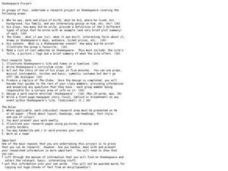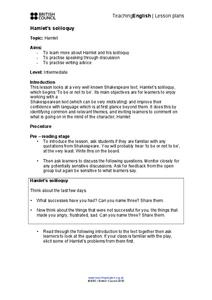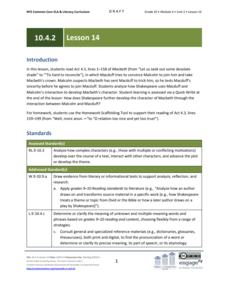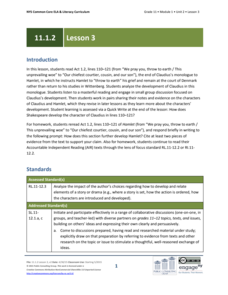Curated OER
Shakespeare Project
Young scholars research the life and times of William Shakespeare and present their research in a variety of ways. They make timelines, act out the story of one of his plays or create word searches.
Curated OER
Shakespear Scavenger Hunt
Pupils use the internet to study basic biographical facts about Shakespeare in the form of an internet scavenger hunt. This activity is a great introduction to a Shakespearean unit of study.
Curated OER
Shakespeare Character Analysis Using "Twelfth Night"
Eighth graders complete a six-week unit on character analysis for the play "Twelfth Night" by William Shakespeare. They conduct research and write a report, participate in a book talk, and create a character analysis assignment to...
Curated OER
New York City: Passionate About Shakespeare
High schoolers read passages from Shakespeare and have a Town Hall meeting in which they defend Shakespeare as part of American culture.
Curated OER
Playing Humanity: Comparing Shylock and Antonio
Students read a scene of "The Merchant of Venice" and write remarks by Antonio and Shylock that indicate traits of their personalities. They enact both characters and discuss the treatment of anti-Semitism, bigotry, persecution and mercy.
Curated OER
Writing Task
Eighth graders consider parallel relationships in Much Ado About Nothing and the structure of the play within an extended piece of writing. In this point of view lesson, 8th graders examine relationships and write a discursive...
Curated OER
Much Ado About Nothing: Bloom's Taxonomy Questioning Strategy
Do your class members’ questions lack depth? “Sigh no more . . .sigh no more.” Use a questioning strategy based on Bloom’s taxonomy to encourage readers to create questions that probe the themes of any text. The model discussion...
Curated OER
Hamlet's Soliloquy
Everyone is familiar with the beginning of Hamlet's soliloquy, "To be or not to be..." While reading Hamlet, help your middle schoolers analyze the lines that follow, but how do you help them make personal connections to the text? Use...
EngageNY
Grade 10 ELA Module 4: Unit 2, Lesson 19
A tragic play includes imperfect heroes, pity and fear, and a fatal flaw. Scholars analyze Shakespeare's Macbeth as an example of the tragedy genre. Pupils demonstrate understanding by completing a Quick Write discussing how Shakespeare...
Global Oneness Project
Clowning Around
Being a clown is hard work — no joke! Emmanuel Vaughan-Lee's Laugh Clown Laugh, a short film about German clown Reinhard "Filou" Harstkotte, asks viewers to consider the various roles played by clowns and to consider the...
EngageNY
Grade 10 ELA Module 4, Unit 2, Lesson 25
How do film adaptations differ from their literary counterparts? Scholars watch and analyze the 2011 Royal Shakespeare Company (RSC) production of Shakespeare's Macbeth. Pupils complete a Quick Write analyzing how the RSC production...
EngageNY
Grade 11 ELA Module 1: Unit 2, Lesson 8
How does Shakespeare employ figurative language to emphasize central ideas in Hamlet? Using an interesting resource, learners complete a Quick Write to answer the question. Additionally, they continue their study of the play by exploring...
EngageNY
Grade 11 ELA Module 1: Unit 2, Lesson 11
What is Hamlet's attitude towards life and death in Shakespeare's Hamlet? Scholars continue reading the play to answer the question, paying particular attention to Hamlet's most famous soliloquy. By holding a discussion and completing...
EngageNY
Grade 10 ELA Module 4: Unit 2, Lesson 2
What is the best way to determine the theme of a text? Pupils analyze how central ideas emerge in Shakespeare's tragedy Macbeth. They work in small groups and engage in a whole-class discussion to discuss the play's plot. Finally,...
EngageNY
Grade 10 ELA Module 4: Unit 2, Lesson 9
How does Shakespeare develop the central idea of agency versus fate in Macbeth? Using the resource, pupils work in small groups to discuss the plot of Act 3.1. Next, they complete a brief writing assignment to analyze how the main idea...
EngageNY
Grade 10 ELA Module 4: Unit 2, Lesson 14
How does Shakespeare further develop Macbeth's character using the interaction between Macduff and Malcolm? Pupils write responses to the question. They continue their analysis of Macbeth with a masterful reading and guided whole-class...
EngageNY
Grade 10 ELA Module 4: Unit 2, Lesson 13
Lady Macduff uses a metaphor to suggest that her husband does not possess the courage of even a tiny, short-winged bird—ouch! Using the resource, pupils discover Act 4.2 of Shakespeare's Macbeth. Using reading, writing, and discussion,...
EngageNY
Grade 11 ELA Module 1: Unit 2, Lesson 20
How does the setting impact other elements within a play? Using a helpful resource, scholars explore the question by completing a Quick Write after reading Act 5.1 of Shakespeare's Hamlet. Additionally, they engage in a whole-class...
EngageNY
Grade 11 ELA Module 1: Unit 2, Lesson 3
How does Shakespeare develop the character of Claudius in the first Act of Hamlet? Using a helpful resource, pupils complete a Quick Write to answer the question. Readers also work in small groups to discuss the characters of Claudius...
EngageNY
Mid-Unit Assessment: Justification for Character and Scene Selection
When it comes to love and midsummer nights, confessions are tricky. Learners place themselves in the shoes of a character from William Shakespeare's A Midsummer Night's Dream and explain how a character manipulated another character in...
Anti-Defamation League
Should Washington's NFL Team Change Their Name?
"What's in a name?" Is it irrelevant, as Juliet suggests in Shakespeare's play, or is nomenclature deeply significant? Young scholars weigh in on the debate by examining the controversy over the NFL's Washington, D.C. Redskins. Groups...
Curated OER
Julius Caesar: Fate Versus Free Will
Tenth graders engage in a study that is about Julius Caesar while reading a play. The role of the main character is examined while looking for motive and tension presented by Shakespeare. They write a summary and critique of the play.
Curated OER
Shakespeare
Students read specific acts of Shakepeare's King Lear. Using the text, they identify the beginning stages of Lear's insanity and the causes of his instability. They examine the relationship between King Lear and Poor Tom and reenact the...
PBS
Does Art Imitate Life?
Write what you know, sound advice for any writer and something many famous authors are known to have done. Use these materials to explore how Shakespeare's life influenced his plays. This resource is packed with readings, video segments,...























